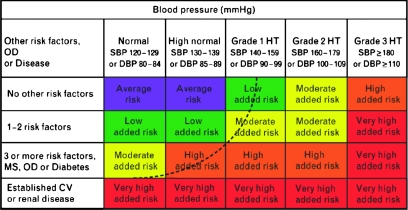Figure 1.
Stratification of cardiovascular risk and its relationship to blood pressure in adults. Reprinted with permission from Mancia et al. (33). OD = subclinical organ damage; SBP = systolic blood pressure; DBP = diastolic blood pressure, HT = hypertension; MS = metabolic syndrome; CV = cardiovascular. As per the European Societies of Cardiology and Hypertension guidelines low, moderate, high, and very high added risk refer to 10-year risk of a CV fatal or nonfatal event relative to the average population risk. These categories are associated with population and occupation-based cohorts and empiric methods of quantitative risk determination. Risk factors are boldfaced in Table 2. The dashed line indicates that the categorization of hypertension might be variable and dependent on total CV risk. For example, a patient with established CV or renal disease might have normal blood pressure limits of 129/84 mmHg, whereas someone with no other risk factors could have 150/95 mmHg as a normal blood pressure limit to achieve the same degree of cardiovascular risk reduction.

